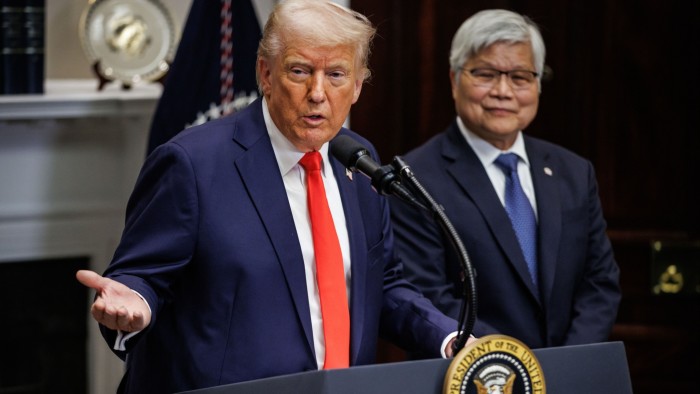Unlock the Editor’s Digest for free
Roula Khalaf, Editor of the FT, selects her favourite stories in this weekly newsletter.
Taiwan Semiconductor Manufacturing Company (TSMC), the world’s biggest chipmaker, has dismissed reports of a tie-up with its ailing US rival Intel, in its first public comment on an idea pushed by Trump administration officials.
TSMC was “not engaged in any discussion with other companies regarding any joint venture, technology licensing or technology transfer and sharing”, chief executive CC Wei told investors on Thursday.
Talks have been reported over the past two months on a potential deal for TSMC to take a minority stake in Intel and help the US chipmaker run its fabrication plants, or fabs, which have for years failed to catch up with the Taiwanese market leader’s technology.
Wei has in the past said that TSMC had no interest in the fabs of Intel, which is also its customer. According to people familiar with the situation, that stance has not changed, but Trump officials repeatedly pressured the company to help rescue Intel.
People familiar with TSMC’s operations and other industry insiders said any attempt to have the contract chipmaker transform Intel fabs so they would match its own would take many years and could cost even more than building new ones.
The Intel proposal was part of the massive disruption that the Trump administration’s tariff and industrial policy moves are bringing to the technology industry.
On Thursday, TSMC maintained its bullish forecast of close to 25 per cent growth this year, driven by booming artificial intelligence chip revenue, but warned that US trade policy would further dilute profit margins and could damage demand.
“We are mindful of the potential impact of all the recent tariff announcements especially on end demand,” said Wei. “Having said that, we have not seen any change in our customers’ behaviour right now, so we stick to our forecast.”
Many of the US‘s major trade partners, including TSMC’s home country of Taiwan, are negotiating deals to reduce steep tariffs Trump announced and then paused this month. Separately, Washington is investigating whether to impose a set of separate tariffs on the entire tech hardware supply chain, including semiconductors, other components and the tools to make them, along with a broad range of downstream products that contain them.
Following pressure from Trump officials, TSMC committed last month to more than double its investment in manufacturing capacity in the US to $165bn to build a total of six fabs, and two advanced packaging facilities.
Offering some new detail on the investments, TSMC said it was working hard to bring forward the start of commercial production at its second factory in Arizona, scheduled for 2028. Wei said TSMC would try to advance that by “a couple of quarters at least”.
That would narrow the technology gap between cutting-edge chip production in Taiwan and the US. The second Arizona fab will make 3-nanometre chips, a technology that will in 2028 be one generation behind the 2nm chips that will start being produced in Taiwan this year.
But management said tariffs would over the next five years cut deeper into the company’s gross margins, already affected by capacity expansion abroad where construction and operating costs are higher than in Taiwan.
Wendell Huang, chief financial officer, said the previously forecast gross margin dilution by 2 to 3 per cent a year would widen to up to 4 per cent towards the end of that five-year period.
According to Wei, 30 per cent of TSMC’s capacity for 2nm and newer process technology will be in Arizona once all of the fabs it plans to build are running — a target roughly in line with analyst estimates but likely to be reached only by around 2030 or later.
TSMC reported a 60 per cent jump in net profit for the first quarter of 2025 compared with the same period a year earlier. Net income surged to NT$361.56bn ($11.13bn), driving the gross margin up to 58.8 per cent, near the top end of the guidance management gave three months ago. Revenues increased 41.6 per cent to NT$839.3bn, in line with the company’s projections given in January.




